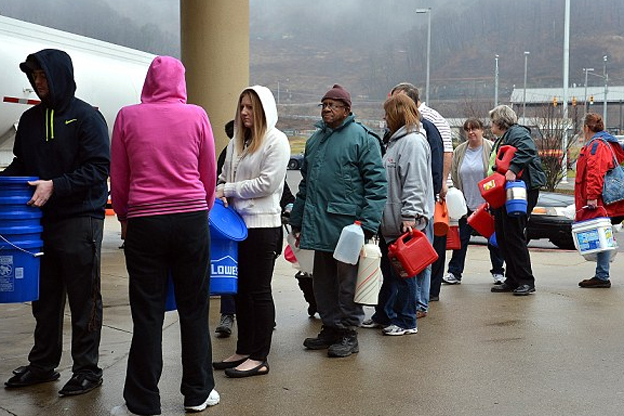

Uh, Minnesota, about that bag you’re holding, part two
Last time, I promised more information about the State of Minnesota’s gaping holes in its regulatory scheme for sulfide mining. I hinted at one of them: inadequate provision for protecting the public — not just the state — from the harm of mining activity.
Before continuing, however, I feel compelled to point out some of the vessels that West Virginia citizens shown above were lining up to carry water in after the Freedom Industries spill in the Elk River. There are several non-food grade buckets (don’t brine your turkey in one of these, either, or the orange one, for that matter), a couple of gasoline containers, and what looks like a kitty litter bucket. But don’t laugh, my friends. How prepared would you be if suddenly you couldn’t drink — or even touch — the water coming out of you tap?
It is pretty common to require public liability insurance for a hazardous activity (maybe not in W. Va., though), especially as a condition to the issuance of a permit to conduct that activity. Minnesota does, as a matter of fact, require a “certificate of insurance” as part of an application for a permit to open a sulfide mine. Here’s the language from Minn. Rule 6132.1100 about what is required:
a certificate issued by an insurance company authorized to do business in the United States under Minnesota Statutes, section 93.481, subdivision 1, clause (2), confirming that the applicant has a public liability insurance policy in force for the mining operation for which the permit is sought or evidence that the applicant has satisfied other state or federal self-insurance requirements, to provide personal injury and property damage protection in an amount adequate to compensate persons who might be damaged as a result of the mining operation or any reclamation or restoration connected with the operation
In an amount “adequate to compensate,” hmmm, how much is that? The rule doesn’t say. I will bet you a quarter that the DNR doesn’t have a clue, either. Maybe it’s just for slip and falls during school tours at the mining site!
Whatever this insurance is, it must be maintained, yessiree Bob. Proof of that has to been in the annual report, filed in duplicate with the DNR by March 31st of each year. I don’t know about you, my friends, but I find the fact that the report must be in duplicate to be oddly reassuring.
If you follow the link to the rule, you’ll see that the insurance required in the annual report is the same as the original insurance required in the permit application. There is no allowance, apparently, for inflation or the discovery of conditions unanticipated in the original permit application.
Significantly, and unlike the adequate financial assurances requirement for the state itself, there is no fund or other “assurance” that the mining company will maintain the insurance after the mine closes and the local mining subsidiary is liquidated, or is otherwise unwilling or unable to maintain the insurance.
Parenthetically, sulfide mining is different than a lot of other hazardous activities that require insurance, because of the long liability tails. If you tell a firecracker manufacturer to cease operations, and it does, the hazard diminishes rather quickly. In the case of a sulfide mine, the hazard probably increases after mine closes.
Even though the mining company permitee’s requirement to file an annual report theoretically continues, um, annually, until all of the reclamation is done and the DNR is satisfied that the site is “maintenance free” (after 200 to 500 years in the case of PolyMet), it is frankly silly to think that an operating subsidiary is going to be around that long to buy public liability insurance.
If the tailings basin at Hoyt Lakes gives way 20 years after the mine closes, chances are there won’t be anybody around to buy you a kitty litter bucket, my friends.
Which bring us to the related hole in the regulatory scheme, and this one may be of the DNR’s own making.
Since PolyMet Mining, Inc., the Minnesota company that would be the operating mining company, is a shell without the capital to open or run mine, and its Canadian parent isn’t really in any better shape, it seems only logical, reasonable, and well, bankerly, to require that the real financial strength behind the whole venture, Glencore/Xstrata, be responsible to the state, and to its citizens, too. In the recent hearing on financial assurances, though, the DNR said, Nah, parents and subsidiaries are one thing, but shareholders are another.
It was a curious remark, in light of the fact that a parent corporation is the shareholder of a subsidiary. The last time I looked, Glencore had invested, in debt and equity, about half of the market capitalization (what the company is worth on the stock exchanges) of PolyMet the parent company. Glencore has an “off take” agreement for the output of any mine that is built.
The only reason anybody would ever buy shares of PolyMet Mining Corp. — assuming you are not Glencore — is the hope that Glencore acquires the rest of the company in a “strategic acquisition.”
It is foolish and chump-like behavior not to acknowledge the Glencore elephant in the room. Without Glencore, PolyMet would fold like a cheap umbrella. No banker would loan money to PolyMet without Glencore’s guaranty; why should we? Pretty clearly, the DNR has the authority to make Glencore come to the table.
And if Glencore is brought to the permit table, my friends, it just might be obligated to maintain the insurance to buy you that kitty litter bucket.
Thanks for your feedback. If we like what you have to say, it may appear in a future post of reader reactions.

